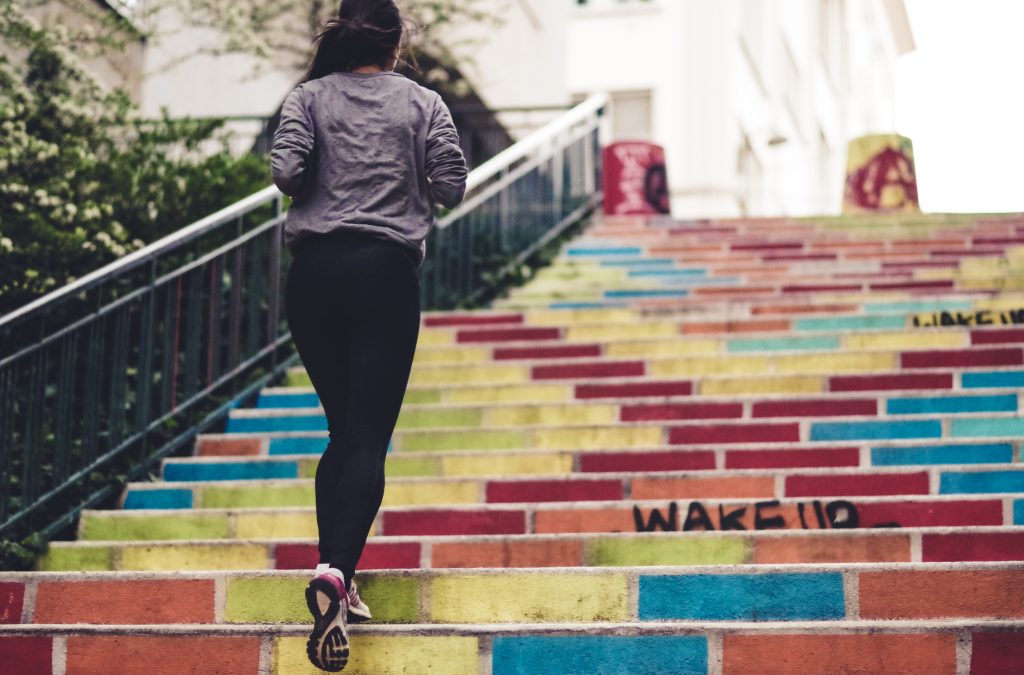Wellbeing as a concept has two main parts – feeling good within yourself, and functioning well in your life. Feeling good within yourself can include feeling happy, content, enjoyment, curious and having a sense of engagement. Functioning well in your life can include having positive relationships, having some control over your life, and having a sense of purpose in your life. You can have a mental illness and still have a good level of wellbeing, and vice-versa, and while mental illness and wellbeing are not the same thing, they are still related concepts.
Research shows that the things we do, as well as how we think, can impact on our wellbeing. This is why it is important to look at all aspects of our life when it comes to wellbeing and making sure we have good wellbeing. However, it’s important that when we are taking action to improve our wellbeing, we don’t view those actions as part of our to-do list; they need to be things we are doing because we want to do them, not just out of a sense of duty.
The Five Ways to Wellbeing framework is an internationally recognised framework that looks at things we can all do to improve our wellbeing. Actions are grouped into five different areas (connection, being active, taking notice, learning, and giving), and the important message of the framework is that its important to find small things within each of these categories that fit your life and your abilities, and that you can enjoy having them as part of your life. It is recommended to try and fit something from each category into your life every day if possible.
- Be Active
Being active doesn’t mean you have to run a marathon or go to the gym everyday. It doesn’t mean you have to be super fit or really active. It just means finding small ways each day to move your body in a manner that works for you, within your ability level.
While being active will not cure a mental illness, it helps to reduce stress levels, it’s an important part of self-care which helps keep us physically and mentally fitter, and so if we are active, we will be more likely to be in a better position to deal with mental health struggles should we encounter them.
Being active can help regulate your sleep, contribute to improved mood through the release of endorphins (also known as stress hormones) as well as helping to manage feelings of stress, anxiety and racing thoughts by getting us out of our minds and into our bodies. It can be a source of social interaction, and can be part of a hobby as well, both of which can help to reduce isolation and loneliness. It also helps to raise self-esteem levels.
There are many ways to be active; the important thing is that it’s something that you are able for, that you enjoy, and that you can fit into your life. If you can be active in nature, that can have even more of an impact on our sense of wellbeing.

Take the stairs instead of the lift
Go for a walk at lunchtime
Walk or cycle to work
Get off the bus a stop earlier than usual and walk the rest of the way
Have a kick-about with some friends
Do some stretches
Go for a walk, jog or run
Go for a cycle
Dance to your favourite song
Try some gardening
Join a local sports team
Go for a swim
Walk the dog
Follow along to a yoga or pilates video on youtube
Planning your activity ahead of time can help you fit it into your schedule and can give you something to look forward to during your week.
2. Connect
Connecting with people can help to build a sense of closeness, and make us feel valued and accepted for who we are. In order to connect with people, you don’t need to be in crowds if that makes you feel uncomfortable. It is possible to find social connection in a way that works for you, and it does not necessarily need to be in a face-to-face capacity.
There are many different ways to connect with people, and different levels at which connections can be made – something as small as saying hello to someone counts as making a connection.
Research shows that when a group of people aged 16 -64 with mental ill-health was compared to a similar group of people without mental ill-health, one of the biggest differences found between the groups was whether or not they engaged in ‘social participation’.
Again, while having social connections won’t prevent or cure a mental illness, they can help reduce feelings of isolation which can impact on our experience of mental illness. Having strong connections with other people can also mean that should you have struggles with your mental health, you may already have people in your life that you can talk to about it; and we know that talking about mental health struggles can help to reduce them.
There are two main kinds of social connections; strong ones that are supportive, encouraging and meaningful; and broad ones that are less strong or deep but are equally important for a sense of connectedness, familiarity, belonging, and sense of self-worth. It’s important to give time to both types for the purposes of improving wellbeing.
There are many ways to connect with people; the important thing is that it’s something that you are able for, that you enjoy, and that you can fit into your life. It’s ok to step outside of your comfort zone, but the important things is that it doesn’t make you feel bad if you do so.

Ask how someone’s day or weekend was, and really listen
Put five minutes aside to find out who a friend or family member is doing
Offer to share a journey with someone
Spend time with family or friends, or reach out to them for a chat
Join groups of like-minded people
Make plans with people you care about and do your best to follow-through on the plans (reschedule them if you do need to cancel)
Try volunteering with your time
If you get along with the people you live with, try sharing a meal with them
Use technology to stay in touch with those that you don’t see as often
Join a book club
Join a sports team
If there is an event happening that you are interested in, try attending, even just for a short while
Smile at someone you see during your day
3. Take Notice
Taking notice of things may sound a bit trivial, but research has shown that becoming more aware of the present moment and how it feels can positively impact wellbeing. It can be easy to pass things by, or forget to check in with ourselves, but it’s worth slowing down even for a moment or two each day to do this if we can.
Taking notice of things can mean taking a moment to check in with how you’re feeling and what you need, but it can also mean to stop and take in your surroundings too. Being aware of how we are feeling can help us to understand what makes us feel that way, and allowing ourselves to actually feel the emotion in the moment can be healthier than ignoring them.
Being in the moment can help us become more appreciative of what we have as if we are fully focused on the present moment, there is less space for thoughts about the past or the future. We have a blog post about mindfulness which might be helpful to read as it relates to this.
If we stop to take notice on a regular basis, it can lead to being more generally aware of our surroundings and how we are thinking and feeling. Research suggests that this can make us more likely to choose behaviours that are more consistent with our needs and values, which in turn can lead to increased wellbeing.

Get a plant for your workplace
Take a different route on your journey home
Make a mental note of five things in your environment as you go about your day
Notice the changing of the seasons
Savour the moment that you are in
Check in with how you are feeling and where in your body you are feeling it
Reflect on experiences as you are having them (or shortly afterwards)
Focus on the task at hand fully
Check in with how others around you are feeling
Engage in deep breathing or progressive muscle relaxation
Journal
Pay attention in the moment to your thoughts
Reconnect with your body and the sensations it is experiencing such as the feel of something you are holding in your hands
Notice your breath in your body
Listen to the sounds of the environment around you
While eating something take some time to think about the taste and texture of what you’re eating
4. Learn
Of course as a student you are constantly learning new things in class and when you study, but we’re learning things in day to day life as well; sometimes without even realising it. While college can often be really difficult and stressful, feeling like you’re learning and developing can help to increase your self-esteem. Lifelong learning has been found to correlate with better wellbeing, life satisfaction, resilience and optimism levels.
Part of learning can involve setting goals, and doing this can also help you to feel more productive and more in control of your life. Learning can also increase social interaction, which reduces isolation, a big risk factor for mental health problems; and depending on the type of learning you do, it could help you to become more active.
Remember, you don’t have to learn for a reason – sometimes doing it just for the fun of it is enough! It’s also ok to learn small things, as long as it interests you.

Find something out about a classmate
Set up a bookclub, or just read a book
Do a puzzle (jigsaws, crosswords, etc)
Learn a new language
Rediscover an old hobby
Learn to play an instrument
Learn to cook something new
Take on a DIY project
Take up a creative hobby
Take a new route home
5. Giving
Giving doesn’t necessarily refer to giving items or money, so you don’t have to be rich or privileged to give – you can give of your time if you have any free. It doesn’t have to be a large amount of time to make an impact both on you and on what you’re giving your time too.
Giving has been shown through research to increase your sense of self-worth and gives you a sense of purpose in society which in turn increases wellbeing.

Make a cup of tea for someone
Introduce yourself to someone new to help them feel more comfortable
Sign up to volunteer with an organisation
Thank someone for something
Join a community group
Spend time with friends or family and be really present
Offer to help someone who needs it
Ask someone to join you for lunch or a coffee
Help a stranger carry their bags

Recent Comments